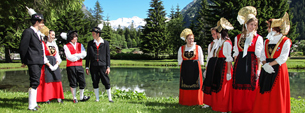The Medieval Age in Valle d'Aosta
By chronological convention the Medieval Age began in Europe in 476 (the removal of the last Roman Emperor) and ended around 1,000 years later; its conclusion has been linked to different dates in each country (birth of national monarchies and the Renaissance). The Medieval Age is divided into three phases: Early Medieval (V-IX century), Middle Medieval (X-XI century) and Late Medieval (XII-part of XV century), mainly and respectively characterised by: the meeting of Barbaric and Latin kingdoms, the re-forming of an idea of "public power" (territorial signoria) and the formation of the State.
The Barbaric invasions in Valle d’Aosta began with the Burgundians, defeated by Theodoric in the VI century.; the region was dominated by the Ostrogoths, to become, some decades later, the province of the Justinian Empire, subsequently taken by the Merovingian Franchi, before the Empire of Charlemagne and the Borgogne reign, up to the gradual arrival in the area of the powerful, future Counts of Savoy (starting in the XI century). From here, mutual cultural and political contacts began in a Valle d’Aosta that was increasingly "passing" between two realities: Italy and France.
Anyone wanting a "taste" of medieval Valdostane culture should firstly visit the castles which represent 1,000 years of architecture, in a small area and fairly unique in Italy. “Encastellation” was a pure feature of this age (enclosing the power of a certain territory). The most picturesque castles (and furnishings) are Fénis and Issogne, as well as those in Sarriod de la Tour (Saint-Pierre), with highly appreciated frescoes. Further historical features include the use of roads as a key political and powerful mechanism (think of the passes, real strategic junctions in the Carolingian Empire, or the important section of Via Francigena) and the assistance service (a thriving hospice network created and managed by clerics, monks and nuns – the most important are located near the Grande and Piccolo San Bernardo).
You should really visit the Church of Sant’Orso, taking a look at the istoriato capitals in the cloister (one of the few cycles in series preserved in Europe), without forgetting the wooden choir, the Ottonian frescoes and the priory (Gothic architecture). The prior in Sant’Orso and some bishops (including Anselmo of Aosta, namesake of the more famous Sant’Anselmo , philosopher and Archbishop of Canterbury) widely encouraged the creation of high quality figurative art, even bringing artists and workers from other areas.
Two curious stories: the priory budgets are a precious source of information because they detail the "descriptions" of the noble kitchens and even the recipes used; some local carnivals , for instance the carnivals in Quart and Verrès , were able to recreate the costumes in use during the noble age on the basis of iconography research.










